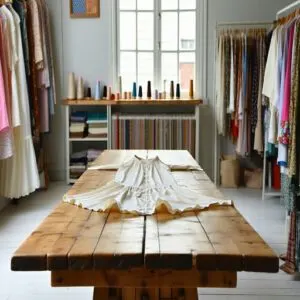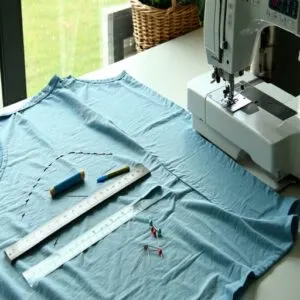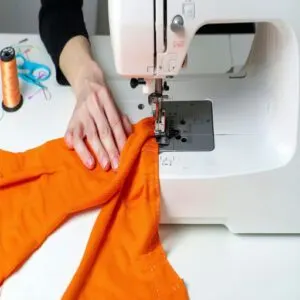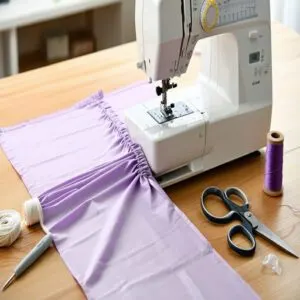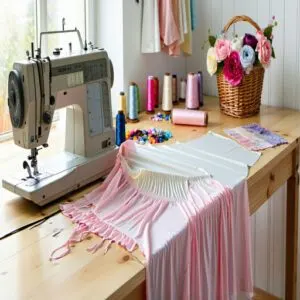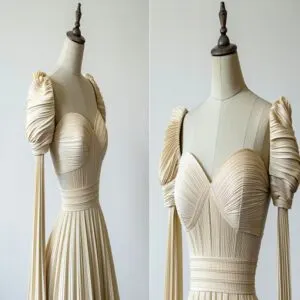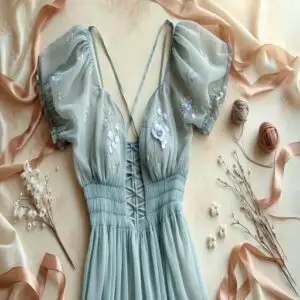This site is supported by our readers. We may earn a commission, at no cost to you, if you purchase through links.
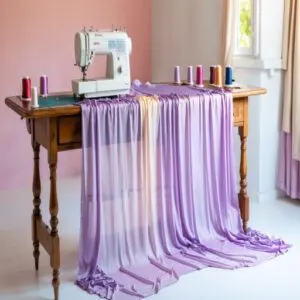 Ruching is a fun way to add texture and shape to fabric, and it’s easier than you think.
Ruching is a fun way to add texture and shape to fabric, and it’s easier than you think.
Start by marking where you want the gathers, then sew long basting stitches or attach elastic to the wrong side of your fabric.
If you’re using basting stitches, gently pull the threads to gather the material until you like how it looks.
For elastic, stretch it as you sew with a straight stitch—it’ll ruche the fabric for you.
Lightweight fabrics like chiffon or silk work best.
Once your ruching is in place, stitch over it to secure, and voilà—textured perfection!
Ready for more tricks?
Table Of Contents
Key Takeaways
- Mark and measure the ruching area carefully before sewing to ensure accuracy and professional-looking results.
- Use either basting stitches or elastic, pulling the threads or stretching the elastic as you sew, to create the gathered texture.
- Lightweight fabrics like chiffon, silk, or organza work best for clean, soft folds that don’t add bulk.
- Always secure your stitches tightly with backstitching to prevent unraveling and maintain polished ruching.
What is Ruching and How Does It Work?
Ruching is a simple sewing technique that gathers fabric to add texture, shape, and flair to your designs.
By pulling or stitching fabric into small folds, you can create beautiful, three-dimensional details that stand out on any garment.
Definition and Purpose of Ruching
Ruching basics are all about fabric gathering to create texture, volume, and those dreamy couture details.
It’s a simple sewing technique that makes your clothes stand out.
With ruching, you can:
- Add texture to plain fabric for a stylish twist.
- Shape garments to flatter curves beautifully.
- Use elastic, ribbon, or thread for endless creativity.
- Turn lightweight fabrics into cascading, ruched perfection.
- Highlight key areas like bodices, sleeves, or waistlines.
To master ruching, understanding pattern making is essential for achieving professional results.
Ruching transforms sewing into an art, giving garments polished, ruched fabric magic!
Different Techniques for Creating Ruching
If you’re diving into the art of fabric gathering, there are some fun ruching methods to explore.
Try basting stitches—just sew long rows, then tug to gather.
Want smoother texture creation? Elastic thread shirring spreads soft gathers over a big area.
For structured folds, pleat fabric and secure it.
Another clever ruching sewing technique is running a cord through a casing for adjustable gathers.
Whether hand sewing ruching or using a sewing machine, experiment boldly for exciting embellishment ideas!
Step-by-Step Guide: Sewing Ruching With Elastic
Sewing ruching with elastic might sound tricky, but it’s actually a simple process once you know the steps.
With a little patience and the right technique, you’ll transform flat fabric into gathered beauty in no time.
Marking and Measuring The Ruching Area
Before jumping into sewing gathered fabric, start by marking where your ruching patterns will go.
Use chalk, a fabric pen, or a ruler to outline the stitching lines. Sharp measuring techniques make all the difference—calculate the area carefully since fabric gathers shorten the length.
Understanding ruching basics is essential for achieving professional-looking results. Pin placement keeps everything in check.
Don’t forget: clean, pressed fabric always works better with any ruching sewing technique!
Attaching and Sewing The Elastic
Start by pinning your elastic to the fabric’s wrong side—you’re aiming for gentle elastic tension here.
Use matching thread for clean results.
To achieve professional results, understanding how to sew elastic is vital for even gathers.
Stretch the elastic as you sew, keeping the fabric smooth.
Use a straight stitch and steady hands for stitch control.
This sewing technique guarantees even ruching.
Practice balancing fabric stretch and machine speed for perfect results!
Securing The Elastic and Finalizing The Ruching
Once the elastic’s stitched, secure it tightly for a polished ruche finish.
Here’s how:
- Backstitch at both ends for seam security.
- Trim excess elastic without cutting fabric.
- Smooth the ruched fabric evenly for your desired ruching depth.
- Check elastic tension—it should stretch naturally.
- Press gently to set the folds.
And voilà, your sewing ruched details look flawless!
Exploring Alternative Methods for Sewing Ruching
If you’re looking to change things up, there are plenty of ways to ruche without using elastic.
From simple basting stitches to hand-sewn smocking, you’ll find creative techniques to add texture and charm to your fabric.
Gathering Fabric With Basting Stitches
Ready to sew ruching with some flair?
Fabric gathering with basting stitches is simple and satisfying.
Mark where you want those gathers, thread your needle, and stitch long, straight gathering stitches along the fabric.
Pull the thread gently to bunch the fabric into soft folds—like magic, the texture comes alive.
Understanding what is gathering is essential for mastering various sewing techniques.
Secure the thread ends to lock it all in place.
Spread the gathers evenly for neat, gorgeous results.
These fabric gathering methods work wonders for sewing ruffles, gathered seams, or adding charming fabric texture to your designs!
Creating Ruching With Elastic Thread (Shirring)
Sewing elastic ruching with shirring is a game-changer for adding texture and flair to clothing.
Load elastic thread into your bobbin and regular thread on top—don’t skip testing thread tension first.
Sew parallel rows 1/4 inch apart using a straight or zigzag stitch. The elastic magically shrinks, creating soft, gathered fabric.
To create a beautiful ruched fabric with a drawstring, consider combining shirring techniques with other gathering methods.
Perfect for ruching necklines, skirts, or sleeves, shirring techniques give garments beautiful stretch and movement while making you feel like a sewing pro.
Hand Stitching Ruching With Smocking Stitches
Hand stitching ruching with smocking stitches? It’s simpler than it sounds and wildly satisfying.
Using a double-threaded needle, tack pleats with straight stitches, then weave in cable stitches for rich textures. Experiment with stitch variations and spacing for unique smocking patterns.
Add lace or trim for extra flair. It’s all about fabric manipulation—your imagination is the limit.
Every stitch brings your fabric to life with outstanding ruching effects!
Incorporating Ruching Into Garment Design
Adding ruching to your garment design can transform a plain piece into something eye-catching and full of personality.
Whether it’s on a bodice, sleeve, or waistband, this technique lets you play with texture and shape to create a look that really stands out, which is a result of the technique.
Using Ruching in Bodices, Sleeves, and Waistbands
Want to elevate your garment’s look? Add ruching to a bodice for elegant embellishments or gather sleeve details for a charming puffed effect.
Cinch waistbands with ruched strips to enhance fabric textures and define garment silhouettes.
This versatile ruching technique turns simple designs into couture-worthy pieces, whether it’s a ruched bodice or perfectly sewn ruched sleeves.
Ruching as a Decorative Accent or Trim
Looking to spice up your wardrobe? Add flair with decorative ruching techniques!
Create eye-catching fabric embellishments by sewing ruching along necklines, sleeves, or hems.
Decorative trims like lace or ribbon can turn a plain waistband into a boho masterpiece.
Ruched fabric sewing works beautifully with soft chiffons or organza, making arm openings dreamy and lightweight.
Textile details like gathered overlays add elegance to dresses or skirts.
These garment adornments are your secret weapon for standout fabric manipulation techniques!
Enhancing Silhouettes With Ruching
Ruching can work magic on your silhouette, adding elegance and curve-enhancing drama.
To master this, try these sewing ruching techniques:
- Pleat and gather fabric carefully before attaching it to emphasize curves.
- Experiment with off-center ruching for unique flair.
- Vary strip widths for dynamic silhouette shaping.
- Layer with contrasting fabrics underneath to boost depth and texture.
Choose lightweight materials for flattering body contouring and effortless waist emphasis.
Choosing The Right Fabric and Effects for Ruching
Choosing the right fabric for ruching can make or break your project, so don’t skip this step.
Lightweight materials like chiffon or stretchy knits work best, giving your gathers that soft, tidy look without turning into bulky chaos.
Ideal Fabrics for Ruching
Fabric selection is key in achieving ruching just right.
Lightweight fabrics like chiffon, silk, and mesh are dream materials for creating those soft, flowing gathers.
Want something crisp?
Organza or voile adds structure without feeling stiff.
For romantic vibes, play with lace or georgette.
In the process of working with sheer fabric, line it for better coverage before getting fancy with your ruching technique.
The right textile types can completely transform garment texture and design, turning simple designs into eye-catching pieces.
Using chiffon fabric techniques can help achieve the desired effect.
Use this ruching fabric guide to match your material choice with the perfect garment texture!
| Fabric Type | Ideal Effect | Best Use |
|---|---|---|
| Chiffon | Light and airy | Dresses, sleeves |
| Organza | Crisp and defined | Formal wear |
| Lace | Romantic texture | Accents, overlays |
Flattering Effects of Ruching on Garments
Looking for a trick to enhance your garment silhouette?
Sewing ruching adds body contouring magic by shaping curves and smoothing over imperfections like a pro.
Waist enhancement? Check. Ruching patterns also boost fabric texture, creating ruched fabric that flatters all the right spots.
It’s a small tweak in garment construction that works wonders for confidence and style, using body contouring to achieve the desired effect.
Other Sewing Techniques Similar to Ruching
If you’re exploring alternatives to ruching, try these fun techniques to create texture and volume:
- Shirring methods: Use elastic thread for gathered stitches with stretch.
- Smocking stitches: Hand-stitch patterns for detailed, decorative flair.
- Pleating techniques: Fold fabric evenly for sharp, structured designs.
- Gathering tools: Thread cords into channels for easy bubbling effects.
Understanding sewing techniques is essential for mastering these methods and achieving professional results.
Mix and match these embellishment ideas to add creativity and uniqueness to your projects!
Frequently Asked Questions (FAQs)
What stitch to use for ruching?
Use a straight stitch when sewing ruching.
For stretchy materials, go with a zig-zag stitch to maintain flexibility.
Don’t forget to backstitch at the start and end to secure everything snugly.
What is the difference between shirring and ruching?
Shirring’s like the stretchy cousin of ruching—it uses elastic thread to gather and stretch fabric, creating flexibility.
Ruching, however, is purely decorative, focusing on folds and gathers to add texture without elastic’s give, which is different from ruching in its functional aspect.
How do you sew gathers on fabric?
Gathering fabric is simpler than you’d think.
Stitch two parallel loose basting lines, then gently tug the threads to bunch the fabric evenly.
Secure it with knots, and voilà—ready for your project!
How do you sew ruching with string?
Did you know ruching can transform plain fabric into something stunning?
To use string, sew a zig-zag stitch over it without catching it.
Pull the string to gather the fabric, shaping gorgeous, textured details.
How do you prevent ruching from unraveling?
Secure your stitches at both ends with tight backstitching so everything stays put.
Use polyester thread for strength, and stitch carefully to avoid gaps.
For extra insurance, tie off threads tightly—no one likes a wardrobe malfunction!
Can ruching be used with non-stretch fabrics?
You can use ruching with non-stretch fabrics by carefully gathering and stitching them.
Lightweight options like chiffon or voile work best.
Just remember, non-stretch fabric ruching adds texture without flexibility, so plan accordingly.
What tools simplify the ruching process?
Think ruching’s tricky?
Tools like elastic thread, gathering foot attachments, and fabric markers simplify the process.
These gadgets give you control, precision, and faster results—turning what seems overwhelming into something you’ll actually enjoy doing with gathering foot attachments!
How to fix uneven or crooked ruching?
Crooked ruching got you frazzled?
Start by unpicking uneven sections with a seam ripper.
Re-pin carefully, keeping spacing consistent.
Sew slowly, stretching fabric evenly.
Patience pays off—crooked stitches don’t stand a chance against your persistence!
Can ruching be added after a garment is sewn?
Ruching can be added after sewing a garment.
Grab elastic or hand-stitch gathers where you want texture.
It’s like giving your outfit a second life—perfect for sprucing up plain pieces or fixing fit issues.
Conclusion
Sewing ruching transforms flat fabric into textured, eye-catching designs—it’s like turning a blank canvas into a masterpiece.
Whether you’re using elastic for quick ruching or basting stitches for more control, the process is simple and full of creative possibilities.
Experiment with lightweight fabrics like silk or chiffon to master how to sew ruching and add stunning detail to garments. From dramatic bodices to decorative trims, ruching lets you elevate your sewing game with stylish, personal flair.

